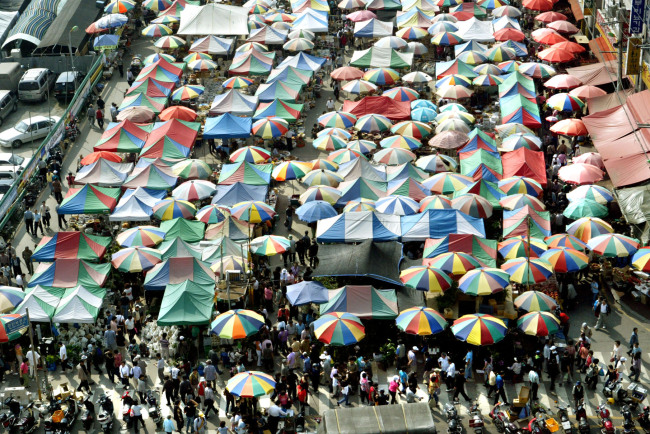[Markets & Merchants] Moran Market has everything you need
Gyeonggi’s biggest traditional market famous for ‘oiljang’ flea market
By Korea HeraldPublished : May 18, 2015 - 18:36
Although Dongdaemun and Namdaemun tend to dominate many lists of “must-see markets” in Seoul, small-scale markets that are equally full of history and character are scattered across the city. This is the sixth installment of a series introducing traditional local markets. ― Ed.
Behind a modern office building near the Bundang Line’s Moran Station lies Gyeonggi Province’s biggest traditional market, called the Moran Market, which has been around for more than 50 years.
It is awfully quiet during weekdays, with only mid-income shoppers visiting, mostly purchasing bottled sesame oil, one of the hottest-selling products at the market. The Moran Market is divided into four submarkets ― sesame oil, oriental medicine, vegetables and dog meat.
Vendors say Moran is most alive when it opens its folk flea market every five days, selling all sorts of goods ranging from food and clothes to household accessories in the parking lot. Called “oiljang,” the five-day interval market opens on days that end in either 4 or 9, such as, the 4th, 9th, 14th and 19th.
Behind a modern office building near the Bundang Line’s Moran Station lies Gyeonggi Province’s biggest traditional market, called the Moran Market, which has been around for more than 50 years.
It is awfully quiet during weekdays, with only mid-income shoppers visiting, mostly purchasing bottled sesame oil, one of the hottest-selling products at the market. The Moran Market is divided into four submarkets ― sesame oil, oriental medicine, vegetables and dog meat.
Vendors say Moran is most alive when it opens its folk flea market every five days, selling all sorts of goods ranging from food and clothes to household accessories in the parking lot. Called “oiljang,” the five-day interval market opens on days that end in either 4 or 9, such as, the 4th, 9th, 14th and 19th.

That is when Moran Market sees transactions of over 1 billion won ($920,000) in a single day, according to oriental medicine pharmacist Lee Myung-su, who has been operating his family-run oriental drugstore in the market for almost three decades.
Moran holds one of the biggest oiljangs, inviting diverse traditional street vendors nationwide, along with Gwangju, Yongin and Icheon in Gyeonggi Province.
“We used to have a motto here: ‘If you can’t get things elsewhere, you can definitely find them here at Moran.’ The market still operates with that motto,” said Lee, 54, who is a former representative head of the Moran Market.
“When we hold the folk flea market, the scale is incomparable to Dongdaemun market.”
Inside a small building in the market where most of its food vendors are located, Chun Myung-ok, who has been running a stand selling handmade chopped noodles, or kalguksu, for about 20 years, said Moran Market has had its ups and downs over the years.
She said the 1988 Summer Olympics in Seoul revived the street food vendors.
The building was raised to relocate all the street food vendors inside as part of the country’s efforts to clean up the streets and promote its image ahead of the games.
“That event really helped revive the food vendors, who had hit a snag amid the region’s development,” said Chun, 60, who runs the noodle store with her daughter.
It is hard to hide the fact that Moran Market was popular for selling dog meat.
During the construction boom of the 1980s, workers came to the market to eat dog meat as it was known to be rich in protein.
However, with the growing negative press depicting Koreans as barbarians for eating dogs after the Olympics, the market gradually saw a decline, especially with its dog meat vendors.
There are currently fewer than 30 dog meat vendors from the more than 50 in the old days. Sesame oil vendors now make up the greatest numbers with more than 50, followed by 40 vegetable stores and about a dozen oriental medicine shops in Moran Market.
Various efforts have been made to promote Moran beyond its aging perception of being just a dog meat market.
Shoppers can buy gift certificates at a 10 percent discount from Nonghyup chains and use them to buy goods at Moran Market.
“Above all, this market has always been and will always be for the low and mid-income families,” said Lee, the oriental drug pharmacist.
If you go:
The Moran Market is located in Jungwon-gu, Seongnam City, a short distance from the Bundang Line’s Moran Station, Exit No. 5. The stores are normally opened between 9 a.m. and 7 p.m.
By Park Hyong-ki (hkp@heraldcorp.com)
-
Articles by Korea Herald








![[KH Explains] Hyundai's full hybrid edge to pay off amid slow transition to pure EVs](http://res.heraldm.com/phpwas/restmb_idxmake.php?idx=644&simg=/content/image/2024/04/18/20240418050645_0.jpg&u=20240419100350)







![[From the Scene] Monks, Buddhists hail return of remains of Buddhas](http://res.heraldm.com/phpwas/restmb_idxmake.php?idx=652&simg=/content/image/2024/04/19/20240419050617_0.jpg&u=20240419175937)

![[KH Explains] Hyundai's full hybrid edge to pay off amid slow transition to pure EVs](http://res.heraldm.com/phpwas/restmb_idxmake.php?idx=652&simg=/content/image/2024/04/18/20240418050645_0.jpg&u=20240419100350)

![[Today’s K-pop] Illit drops debut single remix](http://res.heraldm.com/phpwas/restmb_idxmake.php?idx=642&simg=/content/image/2024/04/19/20240419050612_0.jpg&u=)